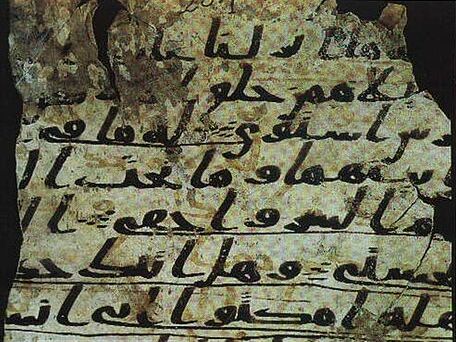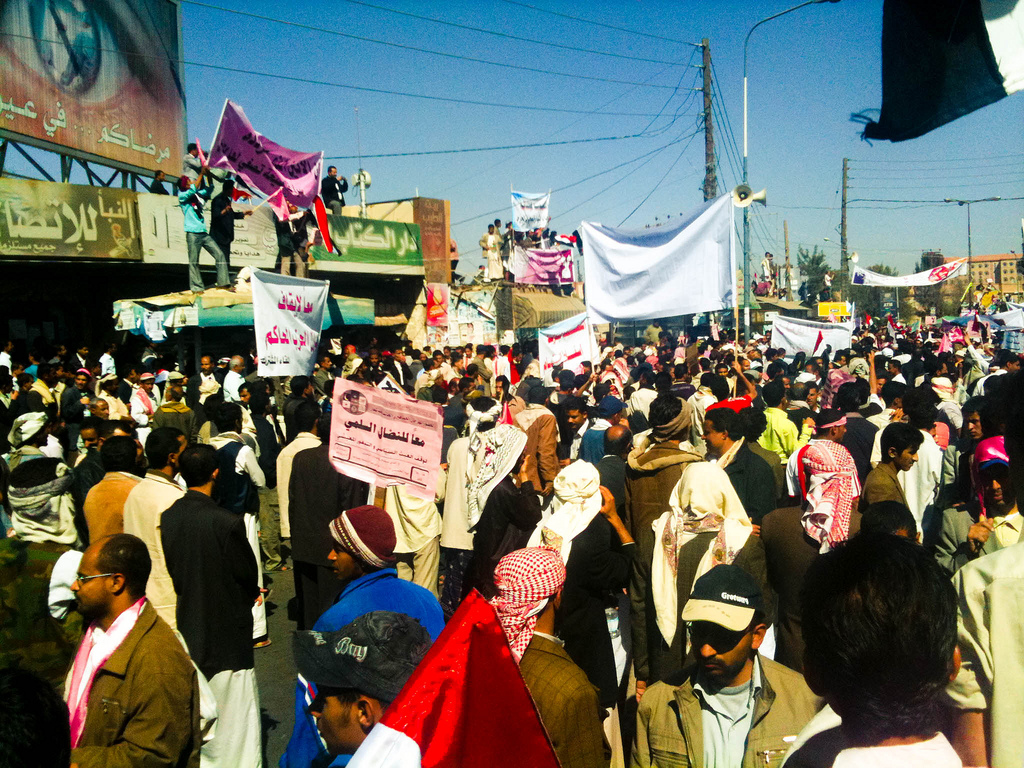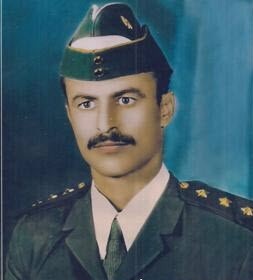|
Presidential Palace, Yemen
The Presidential Palace, also known as the Republican Palace, was the official residence of the President of Yemen. It was located in the al-Sabeen neighborhood of southern Sana'a, Yemen, near Saleh Mosque and al-Sabeen Square (where many pro-Ali Abdullah Saleh political rallies and military parades were held when Ali Abdullah Saleh was in power). The palace area was a heavy security zone, guarded by the Presidential Defense Forces (formerly the Republican Guard) and was not open to the public. On June 3, 2011, during the 2011 Yemeni Revolution, the Presidential Palace was subject to an assassination attack on President Saleh and many government and state officials by opposition tribesmen. It left Saleh injured and seven other top government officials wounded. Saleh, the prime minister, the deputy prime minister, the parliament chief, the governor of Sana'a and a presidential aide were wounded while they were praying at a mosque inside the palace compound.Jamjoom, Mohammed" ''CNN'' ... [...More Info...] [...Related Items...] OR: [Wikipedia] [Google] [Baidu] |
President Of Yemen
The president of the Republic of Yemen is the head of state of Yemen. Under the Constitution of Yemen, the president is also the Supreme Commander of the Armed Forces and head of the executive branch of the Yemeni government. As of 7 April 2022, the powers of the president are exercised by the Presidential Leadership Council, headed by a Chairman. The first and longest-serving president of unified Yemen was Ali Abdullah Saleh and the second was Abdrabbuh Mansur Hadi, who took office on 27 February 2012. The legality of his claim to presidency is in question, as he was the only candidate in the 2012 election and the end of his mandate was originally set for 27 February 2014. His mandate was extended for another year. However, he remained in power after the expiration of his mandate, and on 22 January 2015, he handed over his resignation. He reaffirmed that he intended on resigning two weeks later. After his resignation, the government was assumed by the Houthi Supreme Revolution ... [...More Info...] [...Related Items...] OR: [Wikipedia] [Google] [Baidu] |
Sana'a, Yemen
Sanaa ( ar, صَنْعَاء, ' , Yemeni Arabic: ; Ancient South Arabian script, Old South Arabian: 𐩮𐩬𐩲𐩥 ''Ṣnʿw''), also spelled Sana'a or Sana, is the capital and List of cities in Yemen, largest city in Yemen and the centre of Sanaa Governorate. The city is not part of the Governorate, but forms the separate administrative district of "ʾAmānat al-ʿĀṣima" (). Under the Constitution of Yemen, Yemeni constitution, Sanaa is the capital of the country, although the seat of the Yemeni government moved to Aden, the former capital of South Yemen in the aftermath of the Houthi takeover in Yemen, Houthi occupation. Aden was declared as the temporary capital by President Abdrabbuh Mansur Hadi in March 2015. At an elevation of , Sanaa is one of the highest capital cities in the world and is next to the Sarawat Mountains of Jabal An-Nabi Shu'ayb and Jabal Tiyal, considered to be the highest mountains in the country and amongst the highest in the Middle East, region. S ... [...More Info...] [...Related Items...] OR: [Wikipedia] [Google] [Baidu] |
Saleh Mosque
The People's Mosque ( ar, جامع الشعب, Jāmiʿ aš-Šaʿib) is a modern mosque in Sana’a that is the largest in Yemen. It lies in the southern outskirts of the city, south of the Al Sabeen Maternal Hospital. Originally named Al Saleh Mosque ( ar, جَامِع ٱلصَّالِح, Jāmiʿ Aṣ-Ṣāliḥ), it was inaugurated in November 2008 by the late Yemeni President Ali Abdullah Saleh. The mosque, in size, has a central hall that is with an occupancy capacity of 44,000. The building cost nearly US$60 million to construct. Open to non-Muslims, the mosque is frequented by tourists, and promotes moderate Islam. History Saleh was criticized in 2008 for undertaking such a grand project when the country was suffering from socio-economic problems, wherein 42% of Yemenis lived in poverty and one in five were malnourished, according to United Nations estimates at the time. Several accidents occurred during its construction. The minarets collapsed multiple times, resul ... [...More Info...] [...Related Items...] OR: [Wikipedia] [Google] [Baidu] |
Ali Abdullah Saleh
Ali Abdullah Saleh al-Ahmar (, ''ʿAlī ʿAbdullāh Ṣāliḥ al-Aḥmar;'' 21 March 1947There is a dispute as to Saleh's date of birth, some saying that it was on 21 March 1942. See: However, by Saleh's own confession, he was born in 1947 although there is no source to this claim. – 4 December 2017) was a Yemeni politician who served as the first President of Yemen, from Yemeni unification on 22 May 1990 to his resignation on 25 February 2012, following the Yemeni Revolution. Previously, he had served as President of the Yemen Arab Republic, or North Yemen, from July 1978 to 22 May 1990, after the assassination of President Ahmad al-Ghashmi. Saleh developed deeper ties with Western powers, especially the United States, in the War on Terror. Islamic terrorism may have been used and encouraged by Ali Abdullah Saleh to win Western support and for disruptive politically motivated attacks. In 2011, in the wake of the Arab Spring, which spread across North Africa and the Middle ... [...More Info...] [...Related Items...] OR: [Wikipedia] [Google] [Baidu] |
Republican Guard (Yemen)
The Yemeni Republican Guard ( ar, الحرس الجمهوري اليمني), formerly called the Strategic Reserve Forces ( ar, قوات الاحتياطي الاستراتيجي) between 2013 and 2016, is an elite formation of the Yemen Army. It is currently commanded by the former President Ali Abdullah Saleh's son, Ahmed Saleh. It was most notably involved in the 2011 Yemeni uprising, fighting in favour of the Saleh government. The unit was traditionally relied on as the backbone of the regime, and the unit was the best armed and trained in the armed forces. The Defence Ministry both overlooked and engaged in corruption with the unit in order to ensure the loyalty of the unit's leadership. History The Republican Guard was raised in 1964 by Yemen's Republican and Nasserist regime based on the Egyptian Republican Guard model of a powerful, heavily armored formation defending the capital city against internal threats. The Guard was initially created and trained by Egyptian ... [...More Info...] [...Related Items...] OR: [Wikipedia] [Google] [Baidu] |
2011 Yemeni Revolution
The Yemeni Revolution (intifada), also known as the Yemeni Revolution of Dignity followed the initial stages of the Tunisian Revolution and occurred simultaneously with the Egyptian Revolution of 2011 and other Arab Spring protests in the Middle East and North Africa. In its early phase, protests in Yemen were initially against unemployment, economic conditions and corruption, as well as against the government's proposals to modify Yemen's constitution. The protesters' demands then escalated to calls for the resignation of Yemeni President Ali Abdullah Saleh. Mass defections from the military, as well as from Saleh's government, effectively rendered much of the country outside of the government's control, and protesters vowed to defy its authority. A major demonstration of over 16,000 protesters took place in Sanaʽa, Yemen's capital, on 27 January. On 2 February, Saleh announced he would not run for reelection in 2013 and that he would not pass power to his son. On 3 Fe ... [...More Info...] [...Related Items...] OR: [Wikipedia] [Google] [Baidu] |
Houthis
The Houthi movement (; ar, ٱلْحُوثِيُّون ''al-Ḥūthīyūn'' ), officially called Ansar Allah (' ''Partisans of God'' or ''Supporters of God'') and colloquially simply Houthis, is an Islamist political and armed movement that emerged from Saada in North Yemen in the 1990s. The Houthi movement is a predominately Zaidi Shia force, whose leadership is drawn largely from the Houthi tribe. The Houthis have a complex relationship with Yemen's Sunni Muslims; the movement has discriminated against Sunnis, but also recruited and allied with them. Under the leadership of Hussein Badreddin al-Houthi, the group emerged as an opposition to former Yemeni president Ali Abdullah Saleh. They accused him of corruption and criticized him for being backed by Saudi Arabia and the United States. Hussein accused Saleh of seeking to please the U.S. at the expense of the Yemeni people and Yemen's sovereignty. Resisting Saleh's order for his arrest, Hussein was killed in Sa'dah in 20 ... [...More Info...] [...Related Items...] OR: [Wikipedia] [Google] [Baidu] |
Abd Rabbuh Mansur Hadi
Abdrabbuh Mansur Hadi ( ar, عبدربه منصور هادي, translit=ʿAbd Rabbih Manṣūr Hādī Yemeni pronunciation: ; born 1 September 1945) is a Yemeni politician and former field marshal of the Yemeni Armed Forces who served as the president of Yemen from 2012 until 2022, when he stepped down and transferred executive authority to the Presidential Leadership Council, with Rashad al-Alimi as its chairman. He was the vice president to Ali Abdullah Saleh from 1994 to 2012. Between 4 June and 23 September 2011, Hadi was the acting president of Yemen while Ali Abdullah Saleh was undergoing medical treatment in Saudi Arabia following an attack on the presidential palace during the 2011 Yemeni uprising. On 23 November, he became Acting President again, after Saleh moved into a non-active role pending the presidential election "in return for immunity from prosecution". Hadi was "expected to form a national unity government and also call for early presidential elections within 9 ... [...More Info...] [...Related Items...] OR: [Wikipedia] [Google] [Baidu] |
Saudi Arabian-led Intervention In Yemen , the ruling family of Saudi Arabia
{{disambiguation ...
Saudi may refer to: * Saudi Arabia * Saudis, people from Saudi Arabia * Saudi culture, the culture of Saudi Arabia * House of Saud The House of Saud ( ar, آل سُعُود, ʾĀl Suʿūd ) is the ruling royal family of Saudi Arabia. It is composed of the descendants of Muhammad bin Saud, founder of the Emirate of Diriyah, known as the First Saudi state (1727–1818), and ... [...More Info...] [...Related Items...] OR: [Wikipedia] [Google] [Baidu] |
Presidential Residences
President most commonly refers to: *President (corporate title) *President (education), a leader of a college or university *President (government title) President may also refer to: Automobiles * Nissan President, a 1966–2010 Japanese full-size sedan * Studebaker President, a 1926–1942 American full-size sedan * VinFast President, a 2020–present Vietnamese mid-size SUV Film and television *''Præsidenten'', a 1919 Danish silent film directed by Carl Theodor Dreyer *The President (1928 film), ''The President'' (1928 film), a German silent drama *President (1937 film), ''President'' (1937 film), an Indian film *The President (1961 film), ''The President'' (1961 film) *The Presidents (film), ''The Presidents'' (film), a 2005 documentary *The President (2014 film), ''The President'' (2014 film) *The President (South Korean TV series), ''The President'' (South Korean TV series), a 2010 South Korean television series *The President (Palestinian TV series), ''The President'' ... [...More Info...] [...Related Items...] OR: [Wikipedia] [Google] [Baidu] |
Buildings And Structures In Sanaa
A building, or edifice, is an enclosed structure with a roof and walls standing more or less permanently in one place, such as a house or factory (although there's also portable buildings). Buildings come in a variety of sizes, shapes, and functions, and have been adapted throughout history for a wide number of factors, from building materials available, to weather conditions, land prices, ground conditions, specific uses, monument, prestige, and aesthetic reasons. To better understand the term ''building'' compare the list of nonbuilding structures. Buildings serve several societal needs – primarily as shelter from weather, security, living space, privacy, to store belongings, and to comfortably live and work. A building as a shelter represents a physical division of the :Human habitats, human habitat (a place of comfort and safety) and the ''outside'' (a place that at times may be harsh and harmful). Ever since the first cave paintings, buildings have also become objects or ... [...More Info...] [...Related Items...] OR: [Wikipedia] [Google] [Baidu] |
Buildings And Structures Demolished In 2018
A building, or edifice, is an enclosed structure with a roof and walls standing more or less permanently in one place, such as a house or factory (although there's also portable buildings). Buildings come in a variety of sizes, shapes, and functions, and have been adapted throughout history for a wide number of factors, from building materials available, to weather conditions, land prices, ground conditions, specific uses, monument, prestige, and aesthetic reasons. To better understand the term ''building'' compare the list of nonbuilding structures. Buildings serve several societal needs – primarily as shelter from weather, security, living space, privacy, to store belongings, and to comfortably live and work. A building as a shelter represents a physical division of the :Human habitats, human habitat (a place of comfort and safety) and the ''outside'' (a place that at times may be harsh and harmful). Ever since the first cave paintings, buildings have also become objects or ... [...More Info...] [...Related Items...] OR: [Wikipedia] [Google] [Baidu] |






